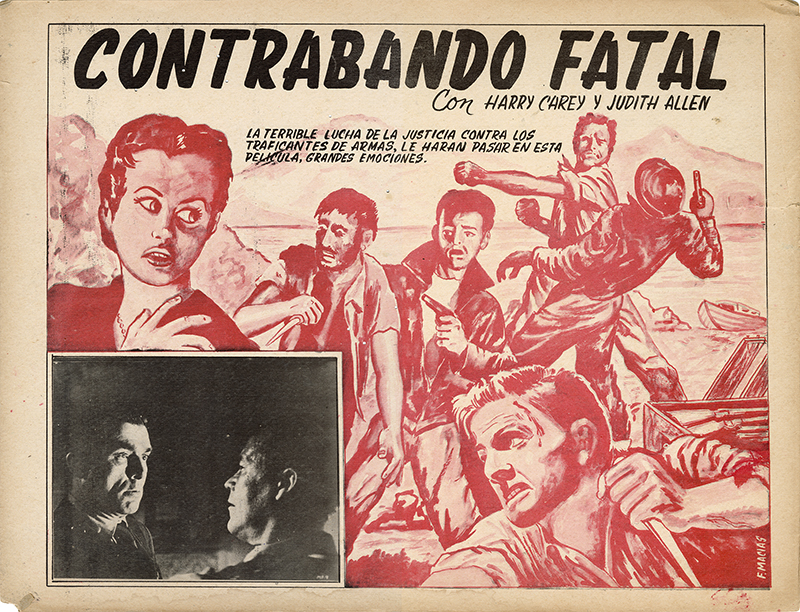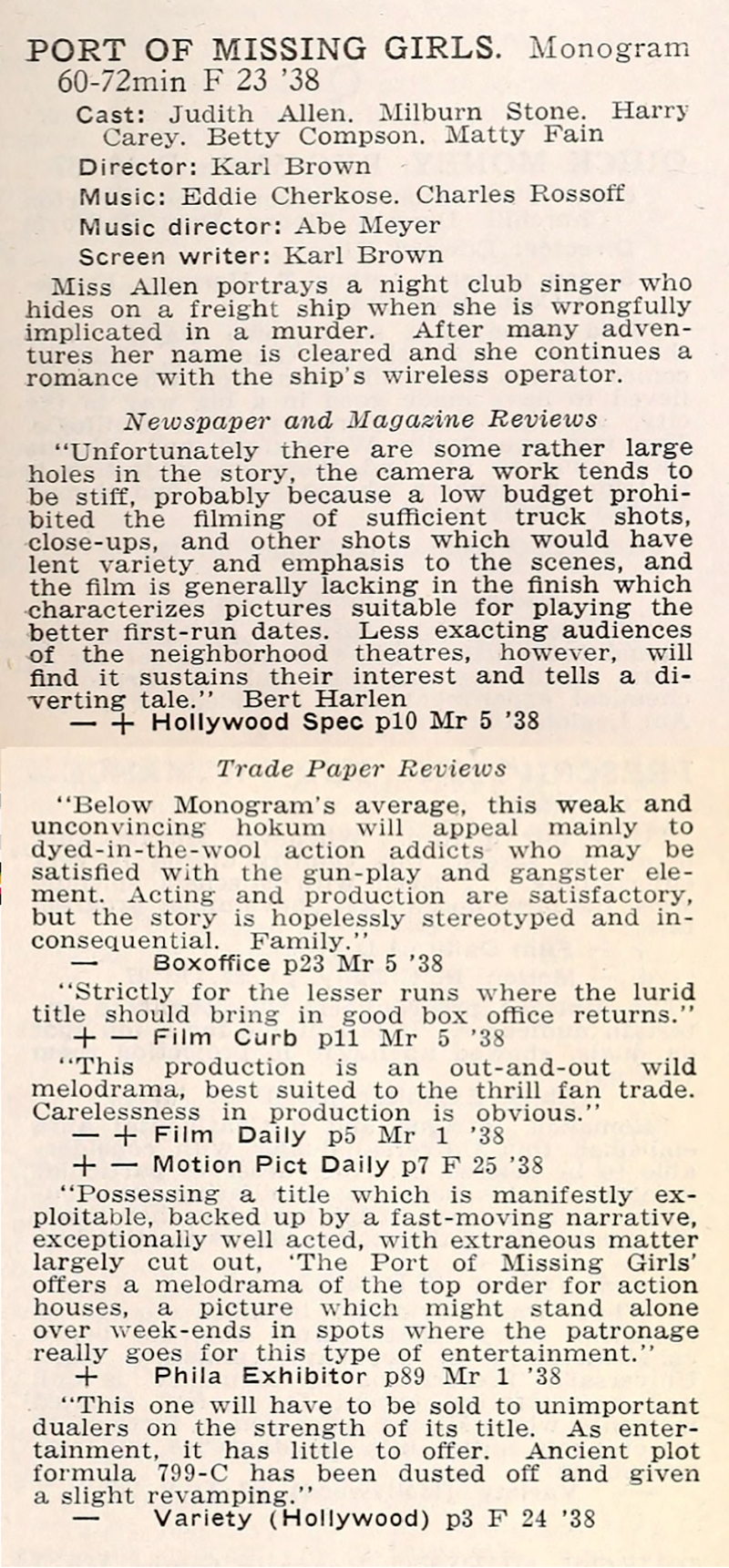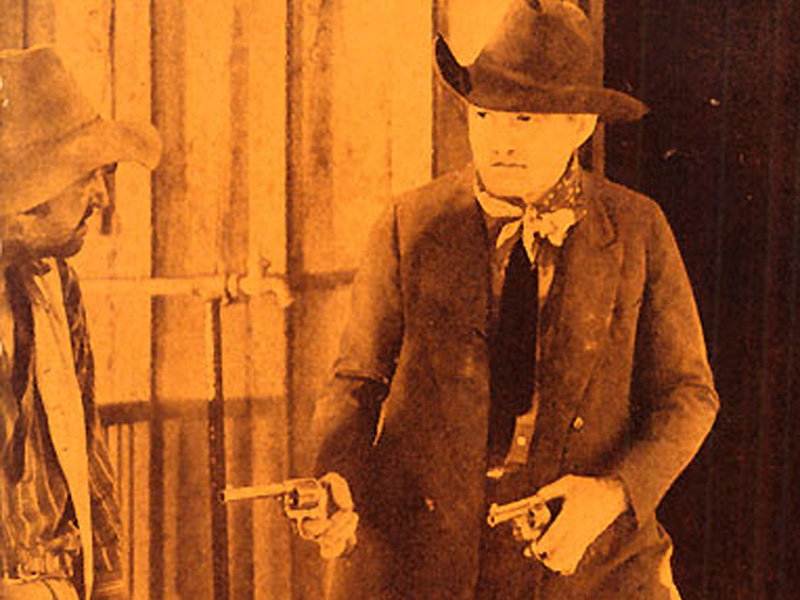|
|


Click image to enlarge
Mexican lobby card, 12½x16½ inches (standard size for Mexico). "Contrabando Fatal" ("Port of Missing Girls"), Monogram Pictures 1938. Card reads:
CONTRABANDO FATAL
Con Harry Carey y Judith Allen La terrible lucha de la justica contra los traficantes de armas, le haran pasar en esta pelicula, grandes emociones.
FATAL CONTRABAND
The fine acting of Saugus rancher Harry Carey Sr. couldn't save "The Port of Missing Girls," which was almost universally panned by critics. Most sources give a release date of February 23, 1938, although some say March 2, 1938 — which would be poetic if it were correct. That was the worst day of the Great Flood of 1938 that killed 113 to 115 people in the greater Los Angeles area. OK, the movie wasn't that bad. Costar Judith Allen plays a nightclub singer who is wrongly accused of murder when she is kidnapped by the real killer. She breaks free from him and for whatever reason is compelled to board a boat full of cutthroats bound for China and captained by Carey. En route she falls in love with the wireless operator, played by Milburn Stone (later Doc Adams from "Gunsmoke"), who helps her hide out in a Shanghai brothel (where the "missing girls" are) until he can establish her innocence. It's a remake of a 1928 picture of the same name, although judging from reviews (which were kinder), the original wasn't a South Seas adventure. In the 1938 version, Carey's ship departs from San Francisco. Port scenes were shot there, and also at the ports of Los Angeles and San Pedro. It's likely the majority of filming was done at a Povery Row studio in Los Angeles, but not necessarily. Ernie Hickson is the technical director, which at the time meant he was in charge of the sets and staging. Hickson was usually the technical director when Monogam used Hickson's Placeritos Movie Ranch in Placerita Canyon (aka Monogram Ranch, later called Melody Ranch). The "driving" scenes appear to use roads in Placerita Canyon. You can watch "Port of Missing Girls" on SCV In the Movies and decide for yourself. Also, the executive producer is Monogram's Paul Malvern, who produced many movies in the Placerita Canyon area. Directed by Karl Brown, "Port of Missing Girls" also features Betty Compson, Matty Fain , George Cleveland, Jane Jones and Willy Castello. Uncredited cast includes Horace B. Carpenter, Jack Cheatham, James Conaty, John Dilson, I. Stanford Jolley, Eddie Kane, Sandra Karina, Rex Lease, Lyle Moraine, Lee Phelps, Charles Rosoff, Shirley Stone, Fred "Snowflake" Toones and Louis Vincenot.
About Harry Carey Sr.
About Harry Carey Sr. Actor Harry Carey (Sr.) acquired a homestead at the mouth of San Francisquito Canyon in 1916 and established a rancho. The ranch included the Carey's wooden ranch home as well as several outbuildings and the Harry Carey Trading Post, which was a tourist attraction that included billed entertainment from Navajo Indians and other performers, along with a store that sold Western and Indian curios. The ranch was occasionally used for filming. The Careys' son, Harry Carey Jr. (Dobe), who would follow in his father's acting footsteps, was born in the Carey ranch home in 1921. The trading post washed away in the St. Francis Dam disaster of March 1928 and was not rebuilt. The Indians left about a month earlier, son Dobe said in a 2005 interview. Dobe said a shaman saw "a big crack and predicted it would break." The ranch house was situated at a higher elevation and survived the flood, only to burn down in 1932. The Careys replaced it by building a Spanish adobe home, which they sold with the rancho in 1945. Harry Carey was born Henry DeWitt Carey II on January 16, 1878 on 116th Street in the Bronx section of New York City. His father was a special-sessions judge and president of a sewing machine company. Harry attended a military academy but declined an appointment to West Point, instead trying his hand as a playwright. According to the Internet Movie Database: In 1911, his friend Henry B. Walthall introduced him to director D.W. Griffith, for whom Carey was to make many films. Carey married twice [correx: 3 times; see here], the [third] time to actress Olive Fuller Golden (aka Olive Carey), who introduced him to future director John Ford. Carey influenced Universal Studios head Carl Laemmle to use Ford as a director, and a partnership was born that lasted until a rift in the friendship in 1921. During this time, Carey grew into one of the most popular Western stars of the early motion picture, occasionally writing and directing films as well. In the 1930s he moved slowly into character roles and was nominated for an Oscar for one of them, the president of the Senate in "Mr. Smith Goes to Washington" (1939). He worked once more with Ford, in "The Prisoner of Shark Island" (1936), and appeared once with his son, Harry Carey Jr., in Howard Hawks' "Red River" (1948). He died Sept. 21, 1947, in Brentwood, after a protracted bout with emphysema and cancer. Ford dedicated his remake "3 Godfathers" (1948) "To Harry Carey — Bright Star Of The Early Western Sky." Carey would appear in at least 233 films, including short features, between 1909 and 1949. Further reading: Harry Carey Ranch: Historic American Buildings Survey No. CA-2712.
LW3223: 9600 dpi jpeg from original lobby card purchased by Leon Worden.
|
FULL MOVIE:
Broken Ways 1913
FULL MOVIE 1938
Fan Reply Card <1928
Marriages
Marked Men 1919
A Fight for Love 1919
Harry & Olive 1919
Overland Red 1920
Canyon of the Fools 1923
The Seventh Bandit 1926 (Mult.)
Satan Town 1926
Burning Bridges 1928
Trader Horn 1931
The Vanishing Legion 1931 (Mult.)
The Devil Horse 1932
Rustler's Paradise 1935
Last of the Clintons 1935
Port of Missing Girls 1938
With U.S. VP John Garner 1940
The Shepherd of the Hills 1941 (Mult.)
Hollywood Walk of Fame
Nat Levine 1988
|
The site owner makes no assertions as to ownership of any original copyrights to digitized images. However, these images are intended for Personal or Research use only. Any other kind of use, including but not limited to commercial or scholarly publication in any medium or format, public exhibition, or use online or in a web site, may be subject to additional restrictions including but not limited to the copyrights held by parties other than the site owner. USERS ARE SOLELY RESPONSIBLE for determining the existence of such rights and for obtaining any permissions and/or paying associated fees necessary for the proposed use.
























